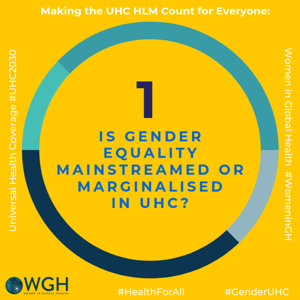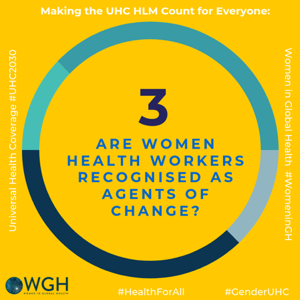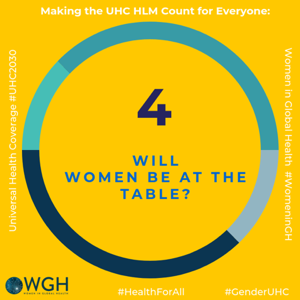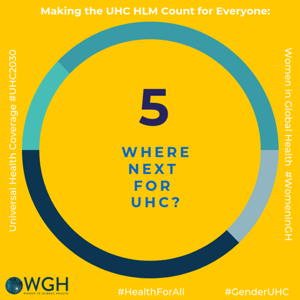Making the UHC HLM Count for Everyone: Five questions from Women in Global Health
- Roopa Dhatt, Executive Director and Ann Keeling
- Sep 21, 2019
- 6 min read

As the Women in Global Health team head for the landmark UN High Level Meeting (HLM) on Universal Health Coverage (UHC) on 23 September 2019, it seems like it has been a long road to New York. And indeed, it has, because Universal Health Coverage is not new. What is new is the determination to share the benefits of UHC with everyone, everywhere, leaving no-one behind.
The World Health Organization (WHO) estimates that around half the world’s population lacks full coverage for essential health services. UN High Level Meetings on specialised topics like UHC are held exceptionally to enable Member States to agree priorities on issues of global importance. This month, Heads of State and Government are in New York for the opening of the UN General Assembly, as well as HLMs on UHC and Climate Change and a High-Level Political Forum on the SDGs. The focus will be on accelerating progress on commitments already made.

New York will be frenzied with blocked roads, wailing motorcade sirens, competing side events and impossibly expensive hotel rooms. Outside the UN, WHO will be leading another Walk the Talk in Central Park and who knows, as seen previously at the HLM for NCDs where advocates, may see some street theatre and protests this year. Sadly, the UHC movement has no equivalent of teenage Climate Change superstar Greta Thunberg. Why not?
We are acutely aware that some NGO representatives from the Global South will not be at the HLM because they were denied visas. This deepens inequity in global health and means critical perspectives are lost, particularly on UHC.
Next Monday’s HLM on UHC is a unique opportunity to secure political commitment from Heads of State and Government and has the potential to change the health and lives of millions of people, the majority of whom are women, who cannot currently afford quality health services. The Director General of the WHO, Dr. Tedros, will be promoting WHO’s ‘triple billion goals’, which include the aim to secure access to UHC to one billion more people benefitting by 2023. These are big numbers and big ambitions that Women in Global Health supports whole heartedly.
The UHC HLM also has the potential to transform the lives of the women who form the majority of the global health and social care workforce. Female health workers currently deliver services to around 5 billion people, and as 70% of the total health and social care workforce, they are the make or break of UHC. Women in Global Health will be in New York to remind everyone that women drive global health.
This meeting is a critical opportunity for the Women in Global Health community to advocate at the global and national levels for gender equality and women’s rights to be central in UHC. We will be asking 5 key questions:
1. Is gender equality mainstreamed or marginalised in UHC?
In March 2019, frustrated that gender equality kept slipping off the UHC agenda, Women and Global Health, Women Deliver and the International Women’s Health Coalition joined together to form an Alliance for Gender Equality and UHC. That Alliance now has 107 NGO member who have worked together seamlessly over the

last months at the national and global levels, with Member States and partners from all sectors, to put gender equality and the rights of women and girls onto the table where they should always have been. The final Political Declaration, stalled for some weeks due to intense negotiations over sexual and reproductive health and rights (SRHR), was agreed mid-September and included commitments on gender equality and women’s rights that were not in the first draft when negotiations started in June. Women in Global Health will be listening intently to speeches, panels and statements by Member States and Non State Actors to gauge commitment to gender equality and the rights of women and girls. Is the Political Declaration another set of commitments that will sit on a shelf in New York and never be implemented; or is there the will amongst governments, civil society and multilateral organisations to make change happen? Much will depend on whether decision makers accept that gender equality and the rights of women and girls really are critical to delivering UHC, or whether they feel that having said the right thing, they can carry on with gender-blind business as usual. Since the HLM is about changing the hearts and minds of Heads of State and Government, who face competing political priorities, every word said at the HLM matters.
2. Does gender also mean men?

Too often gender equality is misunderstood to mean women. But the gender determinants of health drive ill health for all genders, including men. If UHC does not, for example, address the roots of suicide, homicide and accidents that disproportionately affect men it will not impact all causes of preventable deaths. At the HLM we hope to hear widespread understanding that gender equality in health is everybody’s business, men’s as much as women’s.
3. Are women health workers recognised as agents of change?

It is widely understood that trained health workers are essential to the delivery of quality health services, and therefore UHC. WGH has been advocating for a change in narrative: away from viewing women as beneficiaries of health services and to viewing women as fundamental drivers of health. It is critical that political decision makers understand the social and economic opportunities to be gained by investing in decent work for women in the health sector. Currently, women tend to be clustered into lower st atus and lower paid roles in health, and hold only 25% senior decision-making posts[1]. Around half of the US$3 trillion that women contribute to global health each year is unpaid work. Addressing these gender inequities in the health workforce is critical to using the entire talent pool, designing health systems based on the knowledge and health priorities of all genders and filling the 18 million new health worker jobs needed to deliver UHC by 2030. WGH hopes to hear gender inequities in the health workforce raised as issues that will determine delivery of UHC and must therefore be addressed as a matter of urgency.
4. Will women be at the table?

Around 30% of health ministers globally are women, along with 24% of parliamentarians and fewer than 15% of world leaders[2].[3]. Since 2014, only 10% of speakers in the UN General Assembly have been women[4]. A handful of powerful female leaders and former leaders are scheduled to speak at the UHC HLM including Bangladesh’s H.E. Sheik Hasina, former New Zealand premier Helen Clark and Dr. Gro Brundtland, former Prime Minister of Norway and Director-General Emeritus WHO, but their eminent presence cannot disguise the fact that women are sorely underrepresented amongst the world leaders who are the main audience for the HLM. The absence of women’s perspectives and voices at this highest political level will impact negatively upon decisions made on UHC.
5. Where next for UHC?

The temptation, after years of preparatory work for this HLM, may be to breathe a sigh of relief and relax until the next one in 2023. But this HLM is not the end, it is only the beginning: when commitments and partnerships translate into implementation at the country level. The end date of the SDG for UHC implementation is 2030, just over 10 years from now. Until UHC reaches everyone, millions of people will continue to die and suffer from preventable causes, particularly women and girls who are more likely to face financial barriers to accessing healthcare.
WGH, with our growing global network of national chapters, stands ready to support governments as they implement their UHC commitments, as do many other NGOs and organisations working for gender equity in health. Billions of people have waited too long for UHC. WGH want this UHC HLM to be the turning point for #healthforall.
Follow #UNGA74 #HLMUHC #GenderUHC
[1] Delivered by Women, Led by Men: A Gender and Equity Analysis of the Global Health and Social Workforce. Number of pages: 72. Publication date: March 2019.
[2] Delivered by Women, Led by Men: A Gender and Equity Analysis of the Global Health and Social Workforce. Number of pages: 72. Publication date: March 2019.
[3] Laura Kirkpatrick, Women Leaders to Watch at the UN’s Big Meet, Passblue.com 16 September 2019
[4] Laura Kirkpatrick, Women Leaders to Watch at the UN’s Big Meet, Passblue.com 16 September 2019























































Comments